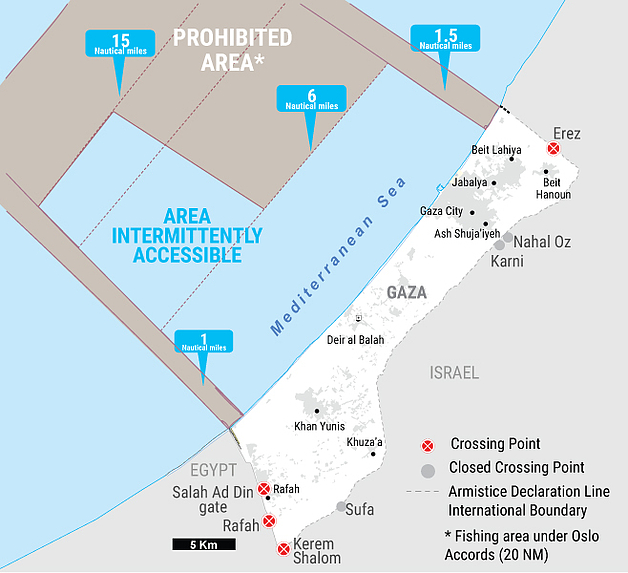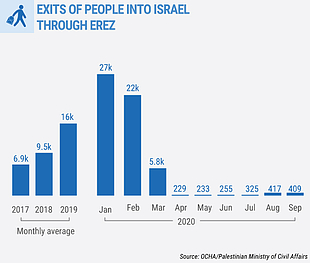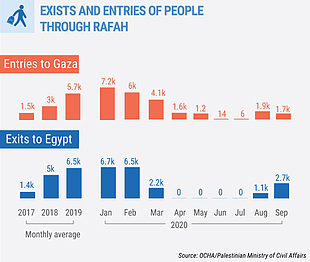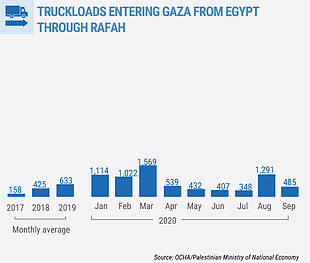Posted on 23 October 2020
Monthly highlights
- Decline in Israeli shooting incidents along the fence and at the sea; two Palestinian fishermen killed by the Egyptian navy.
- Easing of the COVID-related lockdown measures, including movement restrictions between governorates.
- A temporary UN mechanism to support the access of patients to medical treatment in the West Bank and Israel was launched.
- The Rafah passenger Crossing with Egypt opened for three days in both directions.
Protection of civilians and casualties
- On 25 September, Egyptian naval forces opened fire towards a Palestinian fishing boat, which reportedly drifted into Egyptian waters, off the coast south of the town of Rafah, killing two and injuring another.
- On at least 52 occasions, Israeli forces opened warning fire towards Palestinians near the perimeter fence and off the Gaza coast, presumably to enforce access restrictions, resulting in no injuries. This represents a 38 per cent decline from the monthly average of such incidents since the beginning of the year (84).
- On 15 September, Palestinian armed groups fired several projectiles at southern Israel, injuring three Israelis and causing property damage. In response, the Israeli air force attacked military sites in Gaza, resulting in some damage. These hostilities took place during the signing of normalization agreements between Israel, the United Arab Emirates and Bahrain, in Washington, D.C.
Comprehensive data on conflict-related casualties is available at OCHA’s interactive database.
Access
- On 6 September, a temporary mechanism operated by the World Health Organization (WHO) to facilitate the issuance of exit permits for patients and their companions was activated. Its purpose is to mitigate the impact of the halt in coordination between the Palestinian and Israeli authorities, which began in May 2020, in the context of threats by the Israeli government to annex parts of the West Bank.
- In September, 409 people, the majority of whom were patients and their companions, exited Gaza via the Israeli-controlled Erez Crossing, a 40 per cent increase compared to the monthly average of such exits since the outbreak of COVID-19 (April-August). Some 370 people entered Gaza via Erez, nearly the same as in the previous five months.
- On 27 September, the Rafah Crossing with Egypt was re-opened in both directions for three consecutive days, allowing the entry of 1,700 people into Gaza and the exit of 2,659 others to Egypt. The previous opening took place on 11 August.
- Following a decline in the number of active COVID-19 cases, the internal lockdown imposed in late August was gradually eased, including the resumption of movement between governorates, except in the most affected areas in Northern Gaza and Gaza City. The mandatory quarantine period for Palestinians returning from the outside was reduced from 21 to 14 days, seven of which at a quarantine facility and seven at home.
- The number of truckloads of goods that entered Gaza via the Israeli-controlled Kerem Shalom Crossing slightly increased, and those through the Rafah Crossing dropped, compared to the respective monthly averages since the beginning of the year.
Comprehensive data on Gaza crossings is available at OCHA’s interactive database.
Services, Livelihoods and Shelter
- Daily electricity supply reached up to 11 hours throughout the month, the same as in July, and an improvement compared to August (8 hours per day), after Israel resumed the entry of fuel to operate the Gaza Power Plant (GPP) on 1 September.
- Following the increase in power supply, the volume of desalinated water produced in September reached over 7,000 cubic metres per day, a 31 per cent increase compared with August and the largest amount recorded since 2017, when OCHA started tracking this indicator.
- The percentage of essential drugs at zero-stock level (supply for less than a month) stood at 47 per cent in September, the same as recorded in August.
- This month, UNRWA began its third food distribution cycle for 2020 for 1.1 million refugees across Gaza. Also, 125,000 people will receive food assistance from WFP.
An interactive database on electricity supply in Gaza is available at OCHA’s website.
Document Type: Factsheet, Infographic
Document Sources: Office for the Coordination of Humanitarian Affairs (OCHA)
Subject: Access and movement, Casualties, Children, Education and culture, Gaza Strip, Health, Protection
Publication Date: 23/10/2020
URL source: https://www.ochaopt.org/content/gaza-strip-snapshot-september-2020
Document Sources: Office for the Coordination of Humanitarian Affairs (OCHA)
Subject: Access and movement, Casualties, Children, Education and culture, Gaza Strip, Health, Protection
Publication Date: 23/10/2020
URL source: https://www.ochaopt.org/content/gaza-strip-snapshot-september-2020









